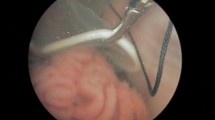Abstract
Background: Maternal morbidity and preterm labor from fetal surgery might be minimized by a percutaneous technique for fetal access and uterine closure.
Methods: In each of 16 ewes, we inserted three trocars percutaneously into the amniotic cavity using ultrasound and fetoscopic guidance. In six ewes, percutaneous uterine closure after the procedure was attempted. We assessed feasibility and acute complications of our technique during surgery and at autopsy.
Results: We achieved percutaneous fetal access in 14 ewes and closed the uterus percutaneously in all six ewes attempted. Fetal injury was related to amnioinfusion or fixation of chorioamniotic membranes. Other complications were trocar dislodgment and damage to uterine wall and chorioamniotic membranes. The latter complication was prevented using balloon-tipped trocars.
Conclusions: Percutaneous intraamniotic access and uterine closure for fetoscopic surgery can be achieved reliably with little maternal and fetal morbidity in sheep. Minor modifications are desired to apply this approach in humans.
Similar content being viewed by others
Author information
Authors and Affiliations
Additional information
Received: 18 September 1996/Accepted: 12 December 1996
Rights and permissions
About this article
Cite this article
Kohl, T., Szabo, Z., Suda, K. et al. Percutaneous fetal access and uterine closure for fetoscopic surgery. Surg Endosc 11, 819–824 (1997). https://doi.org/10.1007/s004649900462
Published:
Issue Date:
DOI: https://doi.org/10.1007/s004649900462




